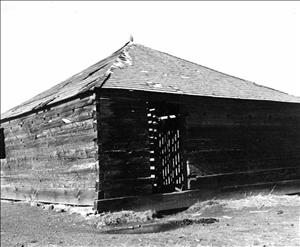In August 1856, U.S. Army Colonel George Wright (1803-1865) establishes Fort Simcoe at the foot of the Simcoe Mountains about 30 miles west of what will become Toppenish, in the future Yakima County. Wright and military leaders hope that the post will keep peace by preventing white settlement of Indian lands. The Army will abandon the post in 1859 and it will become an Indian agency.
Fort Simcoe lay on a trail between the Yakima Valley and the Yakama Tribe’s traditional fishing areas on the Columbia River. The site was a historic camping area for the Yakamas, who called it Mool-Mool or bubbling water. The name Simcoe came from the Sahaptin word Sim-ku-ee or saddle-like dip in a hill. This siting on a heavily traveled Yakama path allowed the soldiers at Fort Simcoe to keep watch over who visited the tribe and what their activities were. Sergeant William H. Kohlhauff (1828-1907) found the grove of oak trees and two large springs while out hunting.
The first commander at Fort Simcoe was U.S. Army Major Robert Seldon Garnett (1819-1861) of Wright's 9th U.S. Infantry Regiment. Garnett took control of the site with two companies of soldiers in early August 1856 as part of Colonel Wright's campaign to quell the Yakama rising. On August 17 Garnett reported that construction of a fort with room for four companies was underway. Supplies for the post were transported by pack trains up the Columbia and Yakima rivers since the wagon road over Satus Pass had not yet been completed.
By the fall of 1856 and the arrival of winter weather, soldiers and quartermaster employees had erected blockhouses and four barracks buildings, but there was no stockade. Officers got cabins in December. Eventually the fort consisted of four officers' homes at the upper end of the parade ground with the barracks and stables at the lower end. The blockhouses were used as homes for the laundresses and blacksmith and for the saddler shops.
In August 1858, Garnett sallied with four companies from Simcoe toward Fort Okanogan to quell an Indian disturbance near there and as part of the Coeur d'Alene War. Along the upper Yakima River and the along Wenatchee River he summarily shot Indians he believed were involved in attacks on prospectors.
In October 1858 Garnett's successor, Captain James J. Archer (1817-1874) hanged two Yakamas, Wap-pi-wa-pi-clah and Stok-an-chan, from a wood beam set in an oak tree at the fort. The men had been implicated in the killing of Indian Agent Andrew. J. Bolon in 1855, an act that helped precipitate the Yakima War.
On April 17, 1859, after they had spent two and a half years building the post and after they had planted their spring gardens, the soldiers received orders to fall in and leave. Two companies marched to Colville to protect the Northwest Boundary Commission's survey of the line between Canada and the U.S. The rest went to Fort Walla Walla.
Fort Simcoe lay within the Yakima Reservation. On May 26, 1859, the 21 buildings of the fort were turned over to the Yakama Indian Agency, part of the Bureau of Indian Affairs. Methodist missionary James Wilbur established a vocational Indian Boarding School on the grounds shortly thereafter.
In 1956, Fort Simcoe became a state park, and in 1974 it was added to the National Register of Historic Places.

